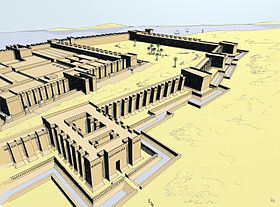Booing
| Boos in hieroglyphics | |||||||
|---|---|---|---|---|---|---|---|
boo bhn |
|||||||
| Greek | Boon | ||||||
| Buhen Fortress (reconstruction, north view) | |||||||
Buhen was an ancient Egyptian fortress and settlement below the second cataract of the Nile in Upper Egypt (historical landscape of Lower Nubia ), near today's border with Sudan . The city was mainly used in the Middle and New Kingdom and had an area of 215 × 460 m. It was on the west side of the Nile across from Wadi Halfa .
history
There was already an Egyptian settlement here in the Old Kingdom , which was probably also a trading post. The settlement was located a little north along the bank and was surrounded by a wall measuring approximately 120 × 950 m. A part of the land wall was protected by a front wall 65 m away with 18 semicircular towers. Numerous seals with names of rulers of the Old Kingdom were found here. The actual fortress was built during the Middle Kingdom as one of several Egyptian border fortresses in Nubia , probably under the rule of King Sesostris I around 1950 BC. AD. The fort was in the Hyksos burned down and in the 18th Dynasty rebuilt.
architecture
The fortress can be divided into three construction phases. Inside was the 150 × 170 m fortress of Sesostris I, with 5 m thick walls and 11 m high particularly strong corner bastions with rectangular towers. In the west wall there were two river gates and a monumental gateway. The outer kennel wall was equipped with semicircular towers arranged in the shape of a clover at the corners. In the northeast corner was the headquarters of the commandant and possibly a temple.
The inner fortress was surrounded by an outer 712 m long wall of Sesostris I with his back to the river. It was 4 m thick, had 32 semicircular towers and had an irregular course. Before the end of the 12th dynasty , a reinforced outer wall was built, which enclosed all four sides. This had numerous rectangular towers, which alternated with larger corner and intermediate bastions. On the north, south and west walls there were monumental gateways, the latter of which was similar to a castle ( barbican ) and had a double kennel.
Between the inner fortress and the north wall were the remains of the brick north temple of Isis from the time of Ahmose . The courtyard was surrounded on three sides by stone pillar halls , behind which there were two wide rooms (apparition and offering room) and a sanctuary with two flanking rooms. Inside the fortress of the Middle Kingdom was the stone south temple of Hatshepsut and Thutmose III. who was dedicated to Horus of Buhen. Along with Amada, the temple was a good example of a common temple from the Thutmosid period. Individual dragged blocks were found in Faras .
meaning
This fortress was the northernmost of a chain of forts used to secure the border with the Cushites . The fortress and settlement still existed in the New Kingdom when the temple in particular was expanded.
Current condition
The ruins of Buhen are now flooded by Lake Nasser . The fortress’s Temple of Horus was dismantled and rebuilt in the museum garden of the National Museum of Sudan in Khartoum .
literature
- Dieter Arnold : Lexicon of Egyptian architecture. Albatros, Düsseldorf 2000, ISBN 3-491-96001-0 , pp. 45-46, → Boo.
- Hans Bonnet : Boo. In: Hans Bonnet: Lexicon of the Egyptian religious history. 3rd unchanged edition. Nikol, Hamburg 2000, ISBN 3-937872-08-6 , p. 128.
Web links
- Minnesota State University e-Museum. Archived from the original on June 3, 2010 ; Retrieved January 19, 2014 .
- Booing (www.digitalegypt.ucl.ac.uk) (English)
- Photographs of the ruins from American research expeditions in 1905-1907 ( Memento from February 25, 2006 in the Internet Archive )
- Essay on Buhen and the neighboring fortresses (Engl.)
Coordinates: 21 ° 55 ′ 0 ″ N , 31 ° 17 ′ 0 ″ E
